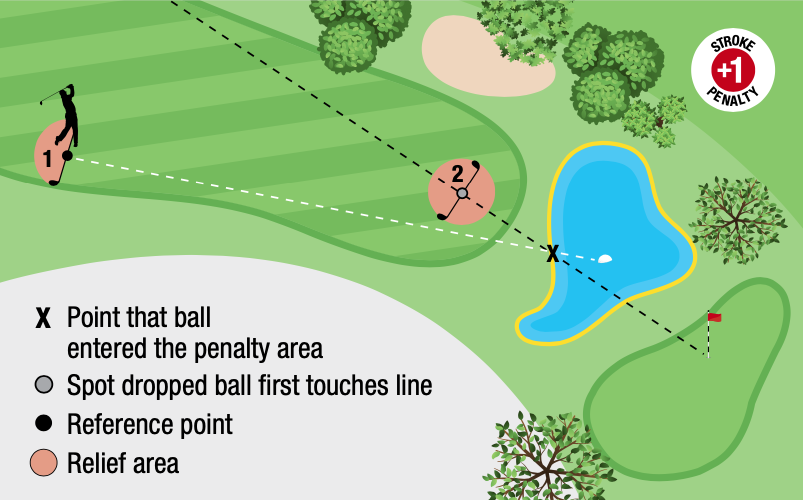What Are Yellow Stakes?
We explain what yellow stakes mean on the golf course and how they differ from red stakes


From January 2019, the term ‘hazard’ ceased to exist within the Rules of Golf and was superseded by the new concept of ‘penalty areas’. These can now cover a variety of different parts of the course where a ball is often lost or unable to be played rather than being restricted to just areas or bodies of water – for example, deserts, jungles and lava rock fields in certain parts of the world.
So, what do you do either if you find your ball in a penalty area or it is known or virtually certain that your ball has ended up in a penalty area? The number of options will depend on whether the area is marked with red or yellow stakes, and it is the latter we are addressing here, from which there are two relief options.
It is worth stressing that if it is not known or virtually certain that your ball has finished in a penalty area (there is no conclusive evidence nor a 95%+ likelihood), then you have no option but to go back to where you last played from under stroke and distance (Rule 18.2).
Assuming you have either found your ball in a yellow penalty area or it is known or virtually certain that it went in, you have two options, both under penalty of one stroke.

This R&A diagram from the 2023 Rules of Golf indicates the two relief options available
The first is to go back to where you last played from under stroke and distance. The reference point for dropping your ball is where the previous stroke was made from, or an estimate of that spot if you are not certain. You then get a one club-length relief area from that spot in an arc that is not nearer the hole and is in the same area of the course as your reference point.
The second ‘back-on-a-line’ relief option changed slightly in terms of the relief area from the 2023 Rules revisions. You may still drop the original ball or another ball outside the penalty area, keeping the estimated point where the original ball last crossed the edge of the penalty area between the hole and the spot where the ball is dropped (with no limit as to how far back the ball may be dropped).

When taking back-on-a-line relief the ball may toll up to one club-length in any direction from where it first touches the ground
But the spot on the line where the ball first touches the ground when dropped creates a relief area that is one club-length in any direction from that point (previously not nearer the hole than the reference point), but with these limits:
Subscribe to the Golf Monthly newsletter to stay up to date with all the latest tour news, equipment news, reviews, head-to-heads and buyer’s guides from our team of experienced experts.
* It must not be nearer the hole than the estimated point where the original ball last crossed the edge of the penalty area, and
* May be in any area of the course except the same penalty area, but
* Must be in the same area of the course that the ball first touched when dropped.
You are not allowed to drop within the penalty area even if it would be practical to do so (e.g., there is an area of grass between the edge of a pond and the yellow stakes).
It is worth mentioning that, from 2019 onwards, committees have had the discretion to mark all penalty areas with red stakes - allowing the extra lateral relief option that these offer - and if the colour of a penalty area has not been marked or indicated by the committee, it is treated as a red penalty area. However, if it is marked with yellow stakes, the lateral relief option is not available to you.

This additional lateral relief option is only available if a penalty area is marked with red stakes, not yellow stakes
And finally, you may always play your ball from a yellow penalty area if safe, practical (and wise!) to do so, and may now even ground your club (as long as you don’t improve the conditions affecting your stroke) and remove loose impediments (as long as you don’t move your ball in the process).

Jeremy Ellwood has worked in the golf industry since 1993 and for Golf Monthly since 2002 when he started out as equipment editor. He is now a freelance journalist writing mainly for Golf Monthly. He is an expert on the Rules of Golf having qualified through an R&A course to become a golf referee. He is a senior panelist for Golf Monthly's Top 100 UK & Ireland Course Rankings and has played all of the Top 100 plus 91 of the Next 100, making him well-qualified when it comes to assessing and comparing our premier golf courses. He has now played 1,000 golf courses worldwide in 35 countries, from the humblest of nine-holers in the Scottish Highlands to the very grandest of international golf resorts. He reached the 1,000 mark on his 60th birthday in October 2023 on Vale do Lobo's Ocean course. Put him on a links course anywhere and he will be blissfully content.
Jezz can be contacted via Twitter - @JezzEllwoodGolf
Jeremy is currently playing...
Driver: Ping G425 LST 10.5˚ (draw setting), Mitsubishi Tensei AV Orange 55 S shaft
3 wood: Srixon ZX, EvenFlow Riptide 6.0 S 50g shaft
Hybrid: Ping G425 17˚, Mitsubishi Tensei CK Pro Orange 80 S shaft
Irons 3- to 8-iron: Ping i525, True Temper Dynamic Gold 105 R300 shafts
Irons 9-iron and PW: Honma TWorld TW747Vx, Nippon NS Pro regular shaft
Wedges: Ping Glide 4.0 50˚ and 54˚, 12˚ bounce, True Temper Dynamic Gold 105 R300 shafts
Putter: Kramski HPP 325
Ball: Any premium ball I can find in a charity shop or similar (or out on the course!)